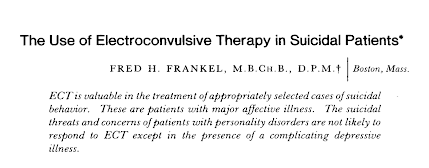Fronto-Medial Electrode Placement For ECT: Computational Modeling Electric Field Study

Out on Pubmed, from authors in the UK and Germany, is this paper: Fronto-medial electrode placement for electroconvulsive treatment of depression. Steele JD, Farnan T, Semple DM, Bai S. Front Neurosci. 2022 Oct 20;16:1029683. doi: 10.3389/fnins.2022.1029683. eCollection 2022. PMID: 36340770 The abstract is copied below: Electroconvulsive therapy (ECT) is the most effective treatment for severe treatment-resistant depression but concern about cognitive side-effects, particularly memory loss, limits its use. Recent observational studies on large groups of patients who have received ECT report that cognitive side-effects were associated with electric field (EF) induced increases in hippocampal volume, whereas therapeutic efficacy was associated with EF induced increases in sagittal brain structures. The aim in the present study was to determine whether a novel fronto-medial (FM) ECT electrode placement would minimize electric fields in bilateral hippocampi (HIP) whilst maximizing ele...









